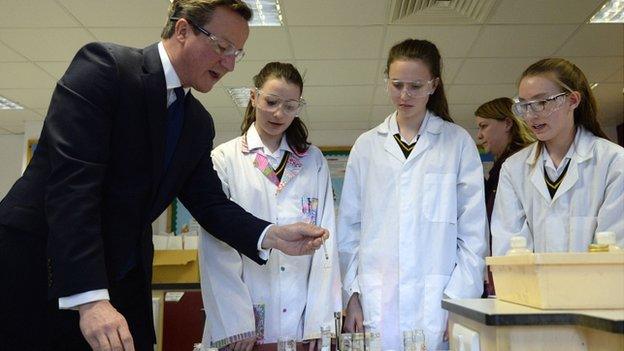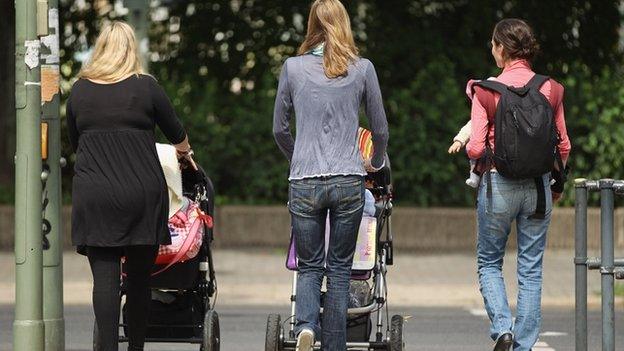Free schools: Successful experiment?
- Published

David Cameron wants to carry on with the formula of free schools and academies. But what's the difference?
When people argue about free schools, they're often not really arguing about free schools.
What they're arguing about is what they think free schools will become.
Are they stalking horses for selling-off state education in England to the private sector? Or are they a test-bed for a more innovative way of running schools?
Will they be a template for creating more school choice? Or are they outriders for a fragmented, deregulated school system that side-steps local democracy?
But when you peel off the ideological wrapping paper, a free school is not really any different from many other schools.
They are academies that have been set up from scratch. They are state-funded, they don't charge fees, and they're not selective. In that respect, they are indistinguishable from a majority of secondary schools in England, which are now academies.
Busy parents
In announcing that the Conservatives want another 500 free schools, Mr Cameron admitted that these schools were "often not understood".
Part of the confusion might have been the initial emphasis on schools being set up by parents, driven by local demand.

The school system faces years of rising demand for places
The use of "parents" is always a good selling point in education, because we assume they mean parents like us, rather than those other parents we don't agree with as much.
But either way, parents are busy people, and in practice it's no great surprise that many free schools are now really being set up by academy trusts, which are in the full-time business of running schools.
The idea that traditional education providers shouldn't have a monopoly on setting up schools is a key ingredient in the free school philosophy, but it's harder to put into practice.
And if an academy trust sets up and runs a school, alongside a portfolio of other academies, within an academy chain, is it a "free school" or just another academy.
In political terms, academies were initially created by Labour and continue to be supported by Labour - and the narrowness of the distinction between an academy and a free school says something about the narrowness of the distinction in education policies.
Rotating nameplates
In the end, parents want to have good schools for their children, they're not overly troubled by the rotating nameplate, which in recent years might have included grant maintained, specialist, city technology, academy or free school.
So how do free schools compare in terms of quality?
Because they sit across a political faultline, there are polarised views on standards in free schools. Polarised, but not particularly revealing.
The common characteristic of free schools is that they are new and haven't replaced existing schools. So what should they be measured against?
Schools are deemed as successful when they have sustained high results or else if they have shown big improvements. Neither really apply for new schools.
The education select committee says the evidence of inspections is still too small scale to draw any meaningful conclusions.
And when these schools are being set up by different groups in different parts of the country, success or failure in one school isn't necessarily relevant to another free-standing school hundreds of miles away.
If a new school opens in a deprived area and the results are mixed, what does it show? And if does well and begins to attract more ambitious, affluent families, is it fair then to accuse a school of "creaming off" or skewing the intake?
Such consumer behaviour in education is always double-edged. If we do it ourselves, it's doing the best for our children; but if other people behave that way, it's the pushy, sharp elbows of the middle class.
Where it does become more thorny is the question of where free schools should be located.
Here there is a much clearer tension between the idea of innovation and parental demand and the more practical pressures of needing a strategically-planned provision of places.
Flagship policy
The other consequence of being a flagship policy is that free schools get a disproportionate amount of attention.
Even if the Conservatives achieve another 500 such schools in five years, it will mean about 900 free schools, out of a total of more than 24,000 other schools.
They might make the on-camera cameo Cameron speeches, but will they be there for the unglamorous heavy-lifting on school improvement?
Free schools in England
408
free schools approved or open
500
more planned within 5 years under Conservatives
-
255 free schools currently open
-
163 approved or open free schools are secondaries
-
154 approved or open free schools are primaries
-
190 approved or open free schools are in London and the south east
The other big numbers ticking away in the background are the rising numbers of families looking for places for children.
The population surge that has seen primary schools adding thousands of new classrooms has now moved upstream to secondary schools.
There will be a huge demand for more school places. Whatever they're called.